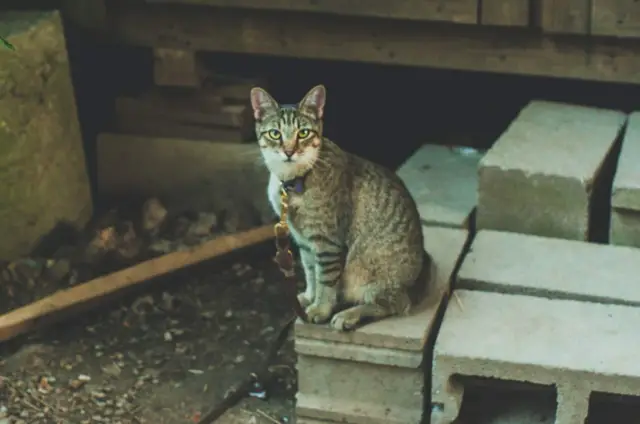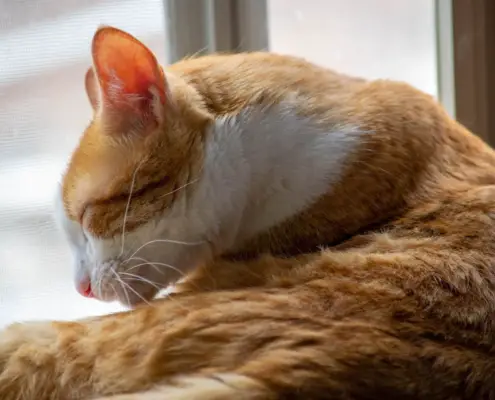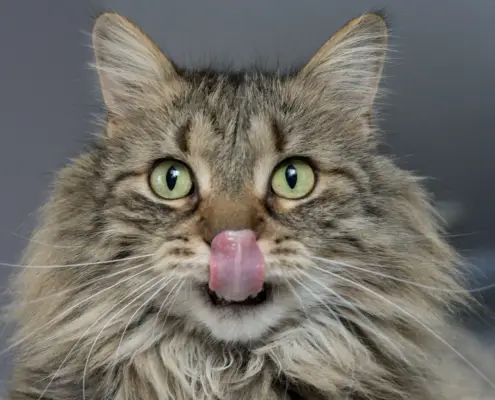
If you’re a cat owner, you’re probably familiar with the sight of your cat shedding its fur. Whether you find clumps of hair on your furniture or have to regularly clean up your cat’s shedding, shedding is a natural process for cats. But why do cats shed their fur? In this article, we’ll explore the fascinating reasons behind this natural process.
Introduction to Cat Shedding
Cats, like many other animals, shed their fur as a part of their natural process. Shedding is the process of losing old or damaged fur to make way for new growth. In the wild, cats shed their fur to adapt to changing weather conditions and to protect their skin from damage. Domestic cats also shed their fur, but they may shed more or less depending on their living conditions and other factors.
The Purpose of Shedding in Cats
The primary purpose of shedding in cats is to regulate their body temperature. Cats have a thick coat of fur that helps keep them warm in colder weather, but this same coat can become uncomfortable in warmer weather. By shedding their fur, cats are able to regulate their body temperature and stay comfortable in changing weather conditions.
Shedding also helps cats remove old or damaged fur from their bodies. This is important for maintaining healthy skin and fur. When cats shed their fur, they remove any dead or damaged fur that could become matted or tangled.
The Shedding Process in Cats
The shedding process in cats is a natural and ongoing process. Cats have a hair growth cycle that consists of three phases: anagen, catagen, and telogen. During the anagen phase, new hair grows from the hair follicle. During the catagen phase, the hair stops growing, and the follicle begins to shrink. Finally, during the telogen phase, the old hair falls out, and the cycle starts again.
Cats shed their fur throughout the year, but they may shed more or less depending on their breed, age, and other factors. Some cats may shed more during certain times of the year, such as in the spring or fall. This is known as seasonal shedding.
Factors that Influence Shedding in Cats
There are several factors that can influence shedding in cats. These include:
- Breed: Some cat breeds shed more than others. Long-haired breeds, such as Persians and Maine Coons, may shed more than short-haired breeds, such as Siamese and Bengals.
- Age: Older cats may shed more than younger cats.
- Health: Cats that are in poor health may shed more than healthy cats.
- Diet: A cat’s diet can also affect shedding. Cats that are fed a diet that is rich in fatty acids, such as omega-3 and omega-6, may shed less than cats that are fed a diet that is low in these nutrients.
Understanding Seasonal Shedding in Cats
As mentioned earlier, cats may shed more during certain times of the year. This is known as seasonal shedding. Seasonal shedding is a natural process that occurs in response to changes in daylight and temperature.
In the spring, cats may shed their winter coat to make way for a lighter summer coat. In the fall, cats may shed their summer coat to make way for a thicker winter coat. Seasonal shedding is a normal and healthy process for cats, and it is nothing to be concerned about.
Health Issues Related to Excessive Shedding in Cats
While shedding is a natural process for cats, excessive shedding can be a sign of an underlying health issue. Excessive shedding can be caused by a variety of factors, including:
- Allergies: Cats may develop allergies to certain foods or environmental factors, such as pollen or dust, which can cause excessive shedding.
- Parasites: Fleas, ticks, and other parasites can cause excessive shedding in cats.
- Skin conditions: Cats may develop skin conditions, such as dermatitis or mange, which can cause excessive shedding.
If you notice that your cat is shedding more than usual, it’s important to take them to the vet for an examination.
How to Manage Shedding in Cats
While shedding is a natural process for cats, there are several things you can do to manage shedding and keep your home clean. Here are a few tips:
- Brush your cat regularly: Regular brushing can help remove loose fur and prevent it from ending up on your furniture or clothing.
- Provide a healthy diet: Feeding your cat a diet that is rich in fatty acids can help reduce shedding.
- Keep your home clean: Vacuuming and dusting your home regularly can help reduce the amount of fur that accumulates on your furniture and floors.
Tips for Reducing Shedding in Cats
If you’re tired of cleaning up after your shedding cat, here are a few tips for reducing shedding:
- Bathe your cat: Giving your cat a bath can help remove loose fur and reduce shedding. However, be sure to use a cat-specific shampoo and follow the proper bathing procedures.
- Use a shedding tool: Shedding tools, such as deshedding combs and gloves, can help remove loose fur and prevent it from ending up on your furniture.
- Use air purifiers: Air purifiers can help remove airborne allergens, such as pet dander and fur, from your home.
Common Misconceptions About Cat Shedding
There are several common misconceptions about cat shedding. Here are a few:
- Shaving a cat will prevent shedding: Shaving a cat may make their fur appear shorter, but it will not prevent shedding. In fact, shaving a cat can cause more harm than good.
- Only long-haired cats shed: All cats shed, regardless of their hair length.
- Shedding is a sign of an unhealthy cat: Shedding is a natural process for cats, and it is not necessarily a sign of poor health.
Embracing the Natural Process of Cat Shedding
In conclusion, shedding is a natural process for cats that serves an important purpose. While shedding can be a nuisance for cat owners, it is nothing to be concerned about. By understanding the shedding process and taking steps to manage shedding, you can keep your home clean and your cat healthy. So embrace the natural process of cat shedding, and enjoy the many benefits of living with a furry feline friend.
If you’re concerned about your cat’s shedding, be sure to talk to your vet. They can help you determine if your cat’s shedding is normal or if there is an underlying health issue that needs to be addressed.
If you enjoyed my article, I would appreciate you sharing it with your network.

Sima Ndlebe
Sima writes for CatBuzz. He is interested in Cats, Health and Fitness, and Entrepreneurship.
Published: 5 December 2023
Related Articles
Disclaimer
The content found on CatBuzz.org is presented on an "as is" basis and is intended for general consumer information and education purposes only. Any utilization of this information is voluntary and solely at the user's own risk.
None of the articles or content should be regarded as, or used in place of, veterinary medical advice, diagnosis, or treatment. The information provided on the website is purely for educational and informational intentions and should not be considered a substitute for professional guidance from a veterinarian or other qualified expert. The articles are designed to inform consumers about veterinary healthcare and medical matters that may impact their cat's daily life. It should be noted that this website and its services do not constitute the practice of any form of veterinary medical advice, diagnosis, or treatment. CatBuzz.org explicitly disclaims any liability for any direct or indirect damages or losses that may arise from the use of or reliance on the information contained within the content.
Consumers must consult a veterinarian, veterinary specialist, or another qualified veterinary healthcare provider when seeking advice regarding their cat's health or medical conditions. It is important not to ignore, avoid, or postpone seeking medical advice from a veterinarian or other qualified veterinary healthcare provider solely based on information obtained from this website. If you believe that your cat may be experiencing a medical issue or condition, it is imperative to promptly contact a qualified veterinary healthcare professional.




